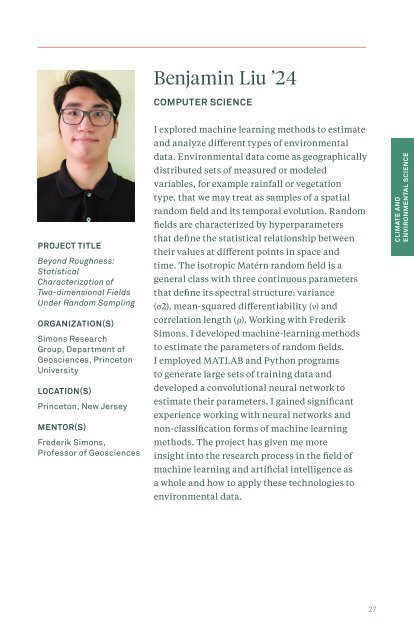Environmental Internship Program - 2023 Booklet
You also want an ePaper? Increase the reach of your titles
YUMPU automatically turns print PDFs into web optimized ePapers that Google loves.
Benjamin Liu ’24<br />
COMPUTER SCIENCE<br />
PROJECT TITLE<br />
Beyond Roughness:<br />
Statistical<br />
Characterization of<br />
Two-dimensional Fields<br />
Under Random Sampling<br />
ORGANIZATION(S)<br />
Simons Research<br />
Group, Department of<br />
Geosciences, Princeton<br />
University<br />
LOCATION(S)<br />
Princeton, New Jersey<br />
MENTOR(S)<br />
Frederik Simons,<br />
Professor of Geosciences<br />
I explored machine learning methods to estimate<br />
and analyze different types of environmental<br />
data. <strong>Environmental</strong> data come as geographically<br />
distributed sets of measured or modeled<br />
variables, for example rainfall or vegetation<br />
type, that we may treat as samples of a spatial<br />
random field and its temporal evolution. Random<br />
fields are characterized by hyperparameters<br />
that define the statistical relationship between<br />
their values at different points in space and<br />
time. The isotropic Matérn random field is a<br />
general class with three continuous parameters<br />
that define its spectral structure: variance<br />
(σ2), mean-squared differentiability (ν) and<br />
correlation length (ρ). Working with Frederik<br />
Simons, I developed machine-learning methods<br />
to estimate the parameters of random fields.<br />
I employed MATLAB and Python programs<br />
to generate large sets of training data and<br />
developed a convolutional neural network to<br />
estimate their parameters. I gained significant<br />
experience working with neural networks and<br />
non-classification forms of machine learning<br />
methods. The project has given me more<br />
insight into the research process in the field of<br />
machine learning and artificial intelligence as<br />
a whole and how to apply these technologies to<br />
environmental data.<br />
CLIMATE AND<br />
ENVIRONMENTAL SCIENCE<br />
27
















